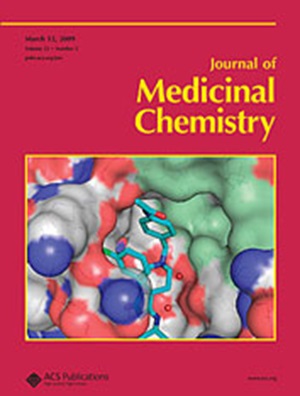Reversible Small Molecule Multivariant Ras Inhibitors Display Tunable Affinity for the Active and Inactive Forms of Ras
IF 6.8
1区 医学
Q1 CHEMISTRY, MEDICINAL
引用次数: 0
Abstract
Activating mutations of Ras are one of the most prevalent drivers of cancer and are often associated with poor clinical outcomes. Despite FDA approval for two irreversible inhibitors that target the inactive state of KRasG12C, significant unmet clinical need still exists, and the susceptibility of non-G12C mutants to inactive-state inhibition remains unclear. Here we report the discovery of a novel series of reversible inhibitors that bind in an enlarged version of the switch I–II pocket with nanomolar affinities. Dependent on chemotype these can either preferentially bind to the inactive or active state or bind both with similar affinity. The active-state binders inhibit the Raf interaction for wild-type Ras, and a broad range of oncogenic KRas mutants with nanomolar potency. A subseries of these molecules displays cellular inhibition of Ras–Raf binding, as well as decreased phosphorylation of the downstream protein ERK, demonstrating that potent multivariant Ras inhibitors can be accessed from this novel pocket.

求助全文
约1分钟内获得全文
求助全文
来源期刊

Journal of Medicinal Chemistry
医学-医药化学
CiteScore
4.00
自引率
11.00%
发文量
804
审稿时长
1.9 months
期刊介绍:
The Journal of Medicinal Chemistry is a prestigious biweekly peer-reviewed publication that focuses on the multifaceted field of medicinal chemistry. Since its inception in 1959 as the Journal of Medicinal and Pharmaceutical Chemistry, it has evolved to become a cornerstone in the dissemination of research findings related to the design, synthesis, and development of therapeutic agents.
The Journal of Medicinal Chemistry is recognized for its significant impact in the scientific community, as evidenced by its 2022 impact factor of 7.3. This metric reflects the journal's influence and the importance of its content in shaping the future of drug discovery and development. The journal serves as a vital resource for chemists, pharmacologists, and other researchers interested in the molecular mechanisms of drug action and the optimization of therapeutic compounds.
 求助内容:
求助内容: 应助结果提醒方式:
应助结果提醒方式:


